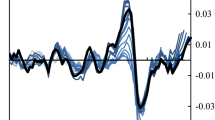Abstract
This paper estimates Japan’s output gap using the recently developed ℓ 1 trend filter, which is an alternative to the popular Hodrick–Prescott (HP) filter. This new filter provides a piecewise linear trend line, which means it possibly provides better output gap estimates than the HP filter does for an economy such as Japan that has experienced some structural breaks.
Similar content being viewed by others
References
Bai J, Perron P (1998) Estimating and testing linear models with multiple structural changes. Econometrica 66: 47–78
Bai J, Perron P (2003) Computation and analysis of multiple structural change models. J Appl Econ 18: 1–22
Cerra V, Saxena SC (2000) Alternative methods of estimating potential output and the output gap: an application to Sweden. IMF Working Paper No. WP/00/59
Fang W, Miller SM (2009) Modeling the volatility of real GDP growth: the case of Japan revisited. Jpn World Econ 21: 312–324
Giorno C, Richardson P, Roseveare D,van den Noord P (1995) Potential output, output gaps and structural budget balances. OECD Econ Stud 24: 167–209
Gómez V (2001) The use of Butterworth filters for trend and cycle estimation in economic time series. J Bus Econ Stat 19(3): 365–373
Hatanaka M, Yamada H (2003) Co-trending: a statistical system analysis of economic trends. Springer, Tokyo
Hodrick RJ, Prescott EC (1997) Postwar U.S. business cycles: an empirical investigation. J Money Credit Bank 29(1): 1–16
Kim S, Koh K, Boyd S, Gorinevsky D (2009) ℓ 1 trend filtering. SIAM Rev 51(2): 339–360
Maravall A, del Río A (2007) Temporal aggregation, systematic sampling, and the Hodrick–Prescott filter. Comput Stat Data Anal 52: 975–998
Rappoport P, Reichlin L (1989) Segmented trends and non-stationary time series. Econ J 99: 168–177
Sato K (2002) From fast to last: the Japanese economy in the 1990s. J Asian Econ 13: 213–235
Tibshirani R (1996) Regression shrinkage and selection via the lasso. J R Stat Soc B 58(1): 267–288
Yamada H (2011) A note on bandpass filters based on the Hodrick–Prescott filter and the OECD system of composite leading indicators. J Bus Cycle Meas Anal 2011(2): 105–109
Author information
Authors and Affiliations
Corresponding author
Rights and permissions
About this article
Cite this article
Yamada, H., Jin, L. Japan’s output gap estimation and ℓ 1 trend filtering. Empir Econ 45, 81–88 (2013). https://doi.org/10.1007/s00181-012-0625-x
Received:
Accepted:
Published:
Issue Date:
DOI: https://doi.org/10.1007/s00181-012-0625-x




